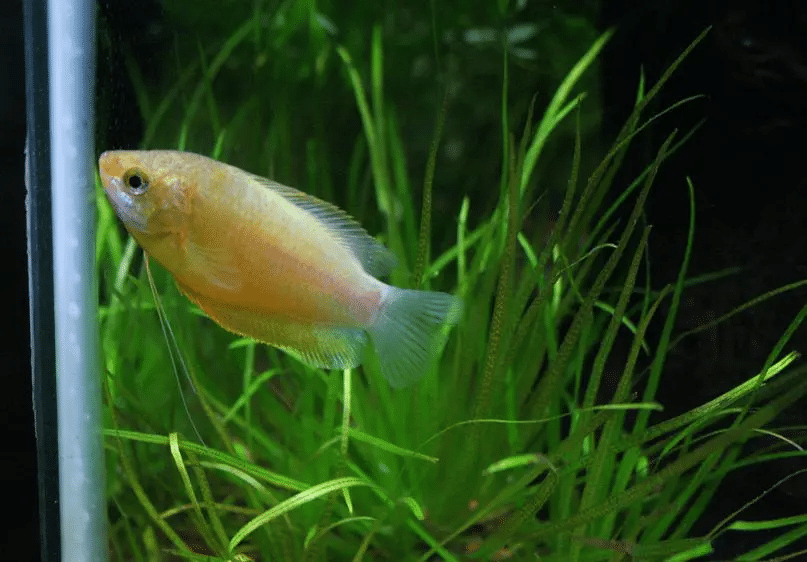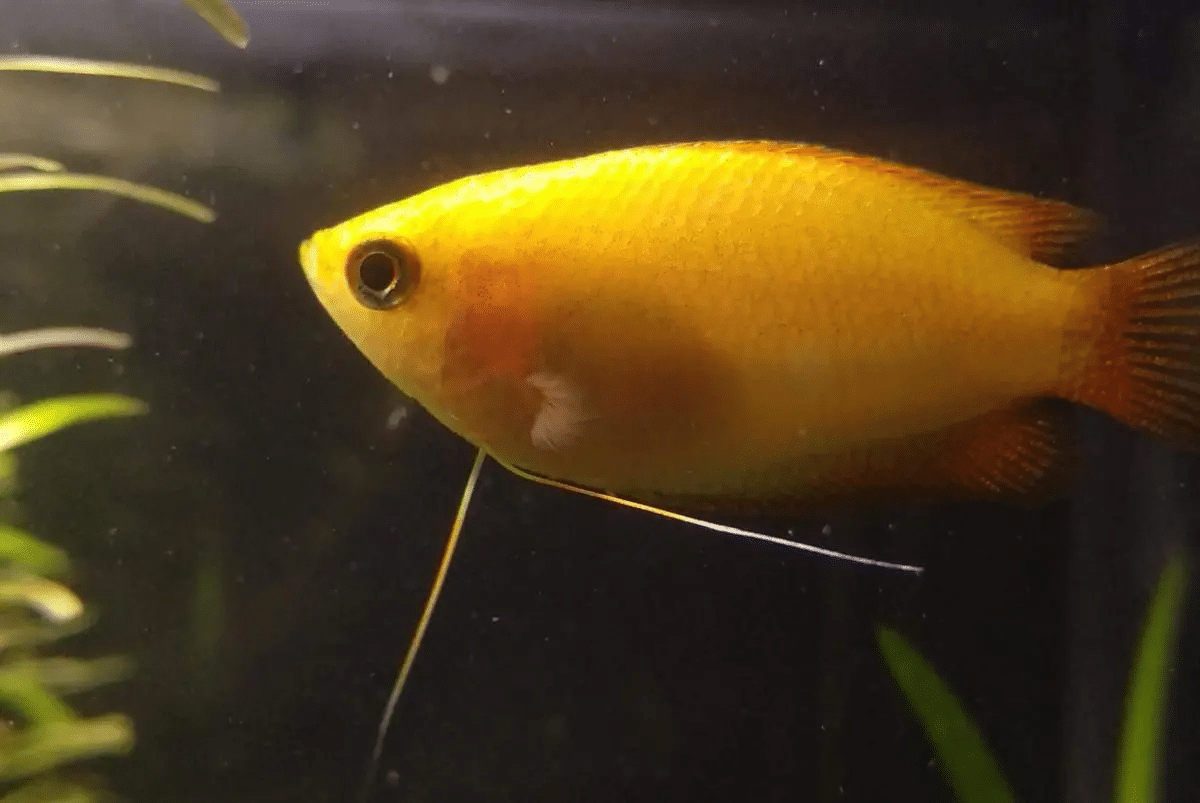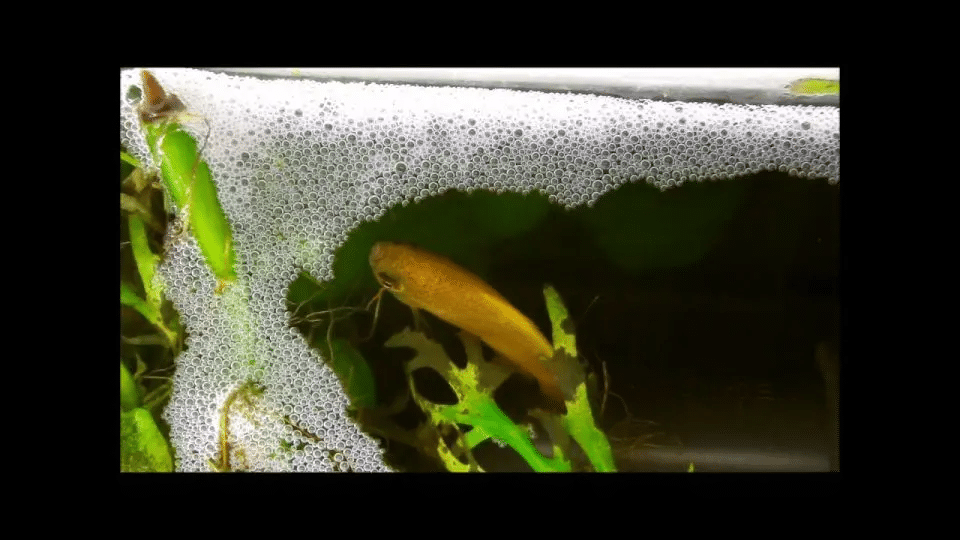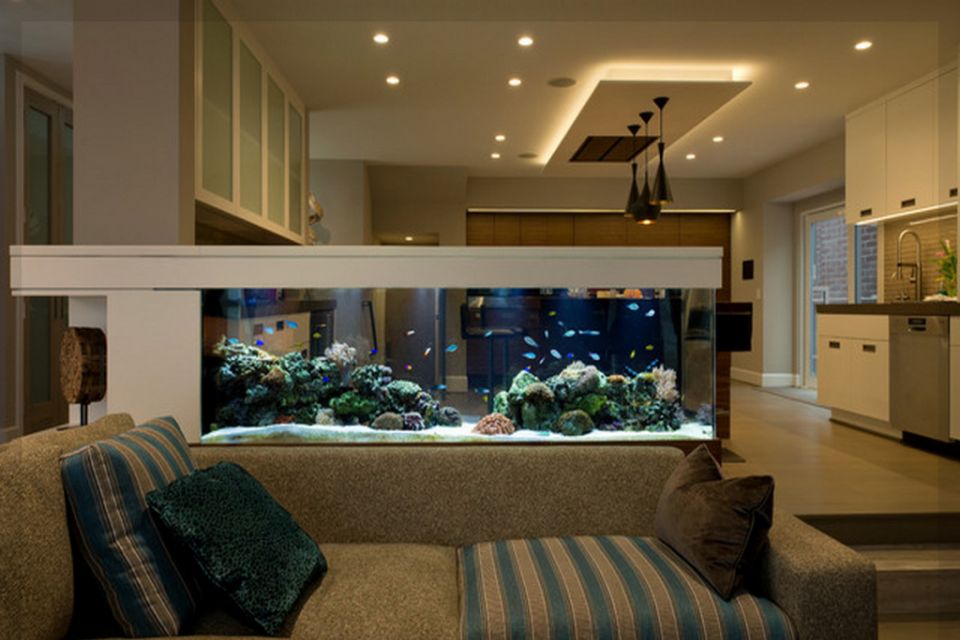
In the following aquaristic guide we will especially deal with the origin, the keeping in the aquarium and the breeding of the beautiful honey gouramis. We will also discuss the preferred water values and other requirements that a Golden Gourami has to meet.
Table of Contents
Everything important about Honey Gourami in a nutshell
- Since the Honey gouramican grow to a maximum length of five centimetres, its existence in the aquarium requires at least an 80 litre aquarium with an edge length of 60 centimetres.
- The animals to be kept in pairs defend their territory very stubbornly during the spawning season.
- The Honey gouramifeels comfortable in an aquarium with a temperature between 22 and 28 degrees. The pH value should be between 6.0 and 7.5. The total hardness should be about 5 to 15°dGH.
- The Golden Gourami feels particularly comfortable in densely planted aquariums. The tank should also be well structured and divided by roots into clear territories. Optimal are sdes furthermore a swimming plant corner as, as well as a rather weak current.
- Basically, the Honey gouramieats any common aquarium food, but the animals like it to be diverse and varied. Not only flake food is highly recommended, but also live and frozen food.
- During the reproductive period, the males of the Golden Gourami build a foam nest directly on the surface of the water. After courtship and fertilization, the clutch inside the foam nest is guarded day and night.
- Under no circumstances should Golden Gourami be kept with fish that are known to pluck the threads of the animals (e.g. Sumatran barbs).
- The honey gourami is also known as Colisa sota, Colisa chuna, Trichopodus sota, Trichogaster chuna or Polyacanthus sota.

Where do honey gourami occur?
Especially in northeastern areas of India, the Golden Gourami is often found. The natural habitat of the honey gourami is the Ganges or Brahmaputra. There they often live in muddy waters with only a very small current. Many of the animals that can be bought in pet shops today come from Bangladesh.
Gourami, as well as the Golden Gourami, are enjoying ever increasing popularity. It is also known that they belong to the group of the so-called Labyrinths, which have a particularly unusual organ. This organ enables the Honey gourami to gasp for air at the water surface. For this reason, honey gouramis or most gourami are often found on the surface of the aquarium.

How many honey gourami keep in the aquarium?
How many honey gouramis you can keep in the aquarium depends strongly on the size of the aquarium. Especially in smaller aquariums you should keep a maximum of one pair of Golden Gouramis, because the animals can become quite aggressive especially during the mating season. In addition, the size of the animals is even more important for keeping them in a 60 liter aquarium: males reach a body length of four centimeters (in rather rare cases 4.5 centimeters), females even reach a maximum length of five centimeters.

However, if the aquarium is larger, several pairs can be kept – especially then the keeping of honey gouramis in the aquarium is especially exciting, because you can observe courtship fights of the males.
In plain language, this means that in an aquarium with an edge length of 60 centimetres, a maximum of one pair of honey gouramis should be kept, while in a 100 centimetre aquarium, two pairs of Honey gourami can be kept.

How do you keep honey gourami in an aquarium?
In principle, honey gouramis are group fish, which should be kept in pairs. The males behave extremely territorial during the nest-building drive, even the females are chased out of the area. It is therefore advisable to keep a pair of Honey gourami in an aquarium with a minimum edge length of 60 centimeters (equivalent to a 54 liter aquarium).
Especially because of the territoriality of the animals the aquarium should be well structured in any case. It should be possible to define clear territories. When keeping in pairs, there should be 2 possible territories per pair. The tank can easily be delimited by decorative objects such as bogwood roots or stones.

If the stocking of several pairs of honey gouramis in the aquarium is planned, one should consider the males, which are quite aggressive among each other. In a larger aquarium, from about 100 centimetres, two pairs can be kept. However, as mentioned above, you have to take care that there are enough possibilities to retreat, otherwise the males will hunt and injure each other.
When setting up an aquarium for Trichogaster chuna, plants are an extremely important component for the well-being of the animals. Especially floating plants, should be abundant in an aquarium with a Golden Gourami, so that the fish have the opportunity to retreat. Typical floating plants that harmonize well with the honey gourami are for example the floating fern, the frog bite and countless species of Salvinia.
To protect the females from male peculiarities (e.g. aggressive behaviour), the plants growing in the aquarium offer the females an ideal shelter. In addition, fish require dense planting so that foam nests can be built during reproduction. Such a nest can reach a size of about 25 centimetres. The floating plants required for this purpose are always directed towards the water surface.

Gravel and sand can be used as tank bottom – both are suitable for keeping honey gouramis in the aquarium without any problems. The choice of the aquarium ground should probably be coordinated with the rest of the stock (species that dig in the sand with barbels etc.).
The right lighting is also extremely important for the well-being of the animals. As mentioned above, the animals originally came from dark and muddy waters. Accordingly, the lighting of the aquarium should be kept relatively dark. Depending on the possibilities, you can dim adjustable LEDs or simply add floating plants to take care of the rest.

Which water values does a honey gourami prefer?
In the shape of an Asian freshwater fish, the honey gourami is mainly attracted to warm and soft water. In contrast to other species, however, small fluctuations in temperature or water value do not have a major impact on the robust Golden Gourami. Honey gouramis feel particularly well in the following specific water values.
- Water temperature: 22 to 28 degrees
- pH value: 6.0 to 7.5
- Total hardness: 5 to 15°dGH
The temperature should be between 22 and 28 degrees. Meanwhile the pH value should be at 6.0 or 7.5. The total hardness reaches its optimum between 5 and 15 dGH. All these values can usually be achieved easily with German tap water. If there are still major deviations, you can buy an osmosis plant to achieve the water values in a targeted manner.

Socialization of honey gourami
Trichogaster chuna are usually not very aggressive towards other species, which makes it possible to socialize with a large number of species. Since gourami are mainly found in the Asian region, Asian species should be used at best. A group of wedge-spotted or luminous-eyed catfishes are particularly well suited as a calm stocking group. If one does not attach great importance to the creation of a biotope, South American characins, such as the red neon or Ember tetras can also be socialized with the golden gourami.
In any case, fin-plucking barbels and other plucking and nibbling species should be avoided.

What does a honey gourami eat?
The food of the Golden Gourami can be varied. Whether live, dry or frozen food a honey gourami is not a particularly choosy ornamental fish. It is also possible to feed the Honey gourami partly with plants. Flake food is a kind of diet for the honey gourami.
The standard food for any kind of ornamental fish, including Trichogaster chuna, consists of either flakes or granules. In the course of live food, it is common to offer fleas, smaller larvae or worms the Trichogaster chuna. The already mentioned frozen food consists of deep-frozen, often very small creatures that have been mixed with a vegetable part. In addition, this food is enriched with minerals and other vitamins.
Otherwise, when feeding the animals, it is important to pay attention to the amount: fasting days should be observed. The feeding time should also be monitored.

How are honey gourami bred?
The process of breeding Golden Gourami is identical to that of gourami. First the animals build an approximately 25 cm large foam nest in which the spawn is deposited. After fertilization, the young fish hatch after about two to three days, which should then be fed with brine shrimp.
In domestic waters the mating season takes place in the months of August to October. During this time, the rivers reach temperatures of 26-30°C – so it becomes particularly warm. In the aquarium, these temperatures, and thus the mating season, can easily be simulated with a control heater. This makes the breeding of the animals very easy and it is often done without the aquarist having to intervene in the process.

Especially if you want to raise the young animals, you should place the male in a second tank before. There the temperature should be the same as in the wild during the mating season. Once the foam nest has been built, the female is added and will spawn there.
After a good two to three days, the young animals have hatched and are able to swim – now the parent animals should be removed from the breeding tank to ensure that they do not interfere with their own spawn. The young animals can now be reared specifically with live food and, if necessary, treated with medication.

The sexes of the animals cannot yet be distinguished at this stage. However, if the animals are large enough, the striking gender differences can hardly be overlooked. The female is much weaker compared to the male. In addition, the female shows a colour stripe along her body. The males also have this strip, but they only wear it in stressful situations.
Conclusion: Easy-care honey gourami
The keeping of a honey gourami is basically quite simple, which is why the animals are also suitable for a beginner aquarium hobby – the possibility to keep the animals in a small 60 litre aquarium makes the animals even more attractive for beginners.
When setting up an aquarium you should stick to a few basic things: The tank should be densely planted with many floating plants. Furthermore, it should be well delimited by roots and stones so that the honey gouramis can form and defend their territories.
As far as the water quality is concerned, golden gourami can certainly make friends with typical German tap water values. Nevertheless you should definitely test your water.
For the socialization of the animals, quiet small schooling fishes, like South American characins or southeast Asian bearblings are especially suitable. Plucking species, such as tiger barbs, should be avoided at all costs.
The breeding of the animals is also not very difficult – it can also succeed in the community tank, where the young animals will probably not survive.



